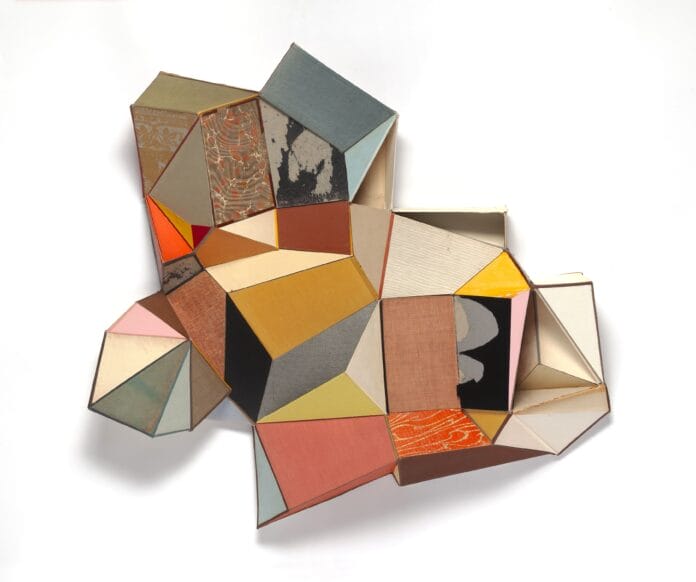In an era dominated by digital media, Conny Goelz Schmitt reminds us of the tactile, storied magic of the printed word—only, in her work, words are no longer read, but seen, felt, and reimagined. Her 2025 wall sculpture Viber is a stunning meditation on the book as both object and idea. Composed entirely of vintage book parts, the 35x35x6-inch piece reframes the physicality of books through a language of form, color, and rhythm.
The Power of Deconstruction
At the heart of Viber lies a philosophical act: the dismantling of familiar things to reveal unexpected potential. Goelz Schmitt deconstructs vintage books—objects often cherished for their content and narrative—and rebuilds them into an abstract construction. With covers, spines, and endpapers forming geometric grids and planes, she liberates these materials from their literary function and gives them a second life.
In doing so, Goelz Schmitt transforms the book into a kind of time capsule. By preserving their aged textures and faded palettes while removing the text, she creates a new story—one not bound by language, but by visual tension and harmony. Each cut and fold becomes a sentence in an unspoken narrative that bridges eras and genres without uttering a word.
A Time Machine of Cultural Memory
Goelz Schmitt describes the book as a “time machine”—a vessel capable of carrying cultural memory while pointing toward new creative futures. In Viber, this concept is palpable. The piece resonates with a sense of nostalgia, not in a sentimental way, but as an invitation to reimagine the familiar. Its precise geometry draws on modernist aesthetics, but the materials ground it in the intimate world of personal libraries, secondhand bookstores, and forgotten shelves.
Viber encourages viewers to consider what happens when content disappears and only form remains. What cultural residue clings to these materials once the words are gone? What stories persist in color, binding, and wear? Goelz Schmitt’s work raises these questions without providing answers—she lets the structure speak.
The Language of Structure and Color
While the book is traditionally a vehicle for linear storytelling, Goelz Schmitt reconfigures it into a spatial narrative. The interplay of surface and depth in Viber creates a rhythmic complexity that draws the eye in and across the sculpture. Color plays a critical role; Goelz Schmitt’s compositions are known for their retro yet refined palettes—a nod to the mid-century Taiwanese color sensibility that has influenced her since her time living in Asia.
The structure of Viber is exacting yet playful. Each component seems carefully calculated, yet the overall composition hums with spontaneity. That balance—between order and improvisation, past and future—is central to her aesthetic.
Biography: A Global Perspective Grounded in Material Practice
Conny Goelz Schmitt’s artistic voice is deeply shaped by her international background. Born in Germany, she studied Sinology and German Literature at Eberhard Karls University in Tuebingen before spending time in Taiwan and eventually relocating to the United States in 1996. This multicultural trajectory informs her sensitivity to both material and cultural nuance.
Now based in Beverly, Massachusetts, Goelz Schmitt works primarily in geometric sculpture and collage, using vintage books as her signature medium. Her practice bridges the meticulous precision of her German roots, the bold chromatics of Taiwanese aesthetics, and the innovative, boundary-pushing ethos of American contemporary art.
Her accomplishments reflect both critical recognition and a sustained commitment to experimentation. She is a 2022 Mass Cultural Council Artist Fellow and has attended esteemed residencies including the Vermont Studio Center (2022) and Pouch Cove, Newfoundland and Labrador (2023). Her work has been honored with numerous awards, such as the Juror’s Choice Award at the 2018 National Prize Show, Best in Show at the CAA’s 15th National Multimedia Exhibition (2016), and Artist of the Year for Sculpture at the 69th Members Prize Show (2014).
Transformation as a Core Theme
Transformation is not merely a visual theme in Viber—it is the conceptual core of Goelz Schmitt’s work. By repurposing obsolete objects into contemporary art, she engages with sustainability in both an ecological and emotional sense. These books, once destined for recycling or neglect, are reborn through her hand. This practice subtly critiques our throwaway culture while celebrating the resilience of physical media.
Goelz Schmitt does not aim to erase the past but to distill it. In Viber, every yellowed edge and faded hue is a fragment of history, preserved and elevated through art. She does not shy away from imperfection; rather, she celebrates it as a sign of life lived—of human touch, time, and use.
Conclusion: A Silent Elegy to the Printed Form
Viber is not loud. It does not shout or demand. It invites—quietly, insistently—into a meditation on books, memory, and transformation. In a world of screens and scrolls, Conny Goelz Schmitt offers a tactile counterpoint: a work that must be felt through the eyes.
Through precision, texture, and the quiet charisma of discarded books, Viber becomes more than a sculpture. It becomes an experience—a conversation between past and future, nostalgia and abstraction, structure and possibility. It reminds us that even in silence, stories endure.


